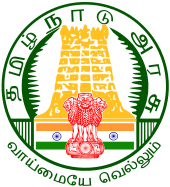Tamil Nadu Legislative Council
|
Tamil Nadu Legislative Council தமிழ் நாடு சட்ட மேலவை Tamiḻnāṭu saṭṭa Mēlavai |
|
|---|---|
| Tamil Nadu | |
 |
|
| Type | |
| Type | |
| History | |
| Established | 1861 |
| Disbanded | 1986 |
| Leadership | |
|
President of the Council (1861 - 1937)
|
NA
|
|
Chairman of the Council (1937 - 1986), (2010 -)
|
NA
|
| Seats | One-third of the strength of Tamil Nadu Legislative Assembly |
| Elections | |
| Proportional representation, First past the post and Nominations | |
| Meeting place | |
 |
|
| Fort St. George 13°04′54″N 80°17′09″E / 13.081539°N 80.285718°ECoordinates: 13°04′54″N 80°17′09″E / 13.081539°N 80.285718°E | |
| Footnotes | |
| See also: Tamil Nadu Legislative Assembly |
|
Tamil Nadu Legislative Council was the upper house of the bicameral legislature of the Indian state of Tamil Nadu. It began its existence as Madras Legislative Council, the first provincial legislature for Madras Presidency. It was initially created as an advisory body in 1861, by the British colonial government. It was established by the first Indian Council Act of 1861, enacted in the British parliament in the aftermath of the Indian Rebellion of 1857. Its role and strength were later expanded by the second Council Act of 1892. Limited election was introduced in 1909. The Council became an unicameral legislative body in 1921 and eventually the upper chamber of a bicameral legislature in 1937. After India became independent in 1947, it continued to be the upper chamber of the legislature of Madras State, one of the successor states to the Madras Presidency. It was renamed as the Tamil Nadu Legislative Council when the state was renamed as Tamil Nadu in 1969. The Council was abolished by the M. G. Ramachandran administration on 1 November 1986. In 2010 the DMK regime headed by M. Karunanidhi tried to revive the Council. The current AIADMK regime has expressed its intention not to revive the council and has passed a resolution in the Tamil Nadu Legislative Assembly in this regard.
The first Indian Councils Act of 1861 set up the Madras Legislative Council as an advisory body through which the colonial administration obtained advice and assistance. The Act empowered the provincial Governor to nominate four non-English Indian members to the council for the first time. Under the Act, the nominated members were allowed to move their own bills and vote on bills introduced in the council. However, they were not allowed to question the executive, move resolutions or examine the budget. Also they could not interfere with the laws passed by the Central Legislature. The Governor was also the president of the Council and he had complete authority over when, where and how long to convene the Council and what to discuss. Two members of his Executive Council and the Advocate-General of Madras were also allowed to participate and vote in the Council. The Indians nominated under this Act were mostly zamindars and ryotwari landowners, who often benefited from their association with the colonial government. Supportive members were often re-nominated for several terms. G. N. Ganapathy Rao was nominated eight times, Humayun Jah Bahadur was a member for 23 years, T. Rama Rao and P. Chentsal Rao were members for six years each. Other prominent members during the period included V. Bhashyam Aiyangar, S. Subramania Iyer and C. Sankaran Nair. The Council met infrequently and in some years (1874 and 1892) was not convened even once. The maximum of number of times it met in a year was eighteen. The Governor preferred to convene the Council at his summer retreat Udagamandalam, much to the displeasure of the Indian members. The few times when the Council met, it was for only a few hours with bills and resolutions being rushed through.
...
Wikipedia
